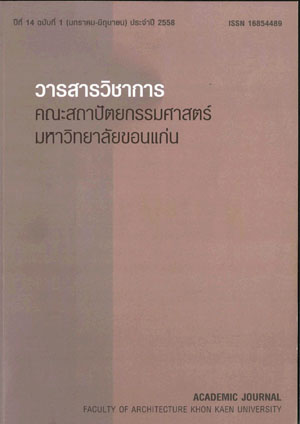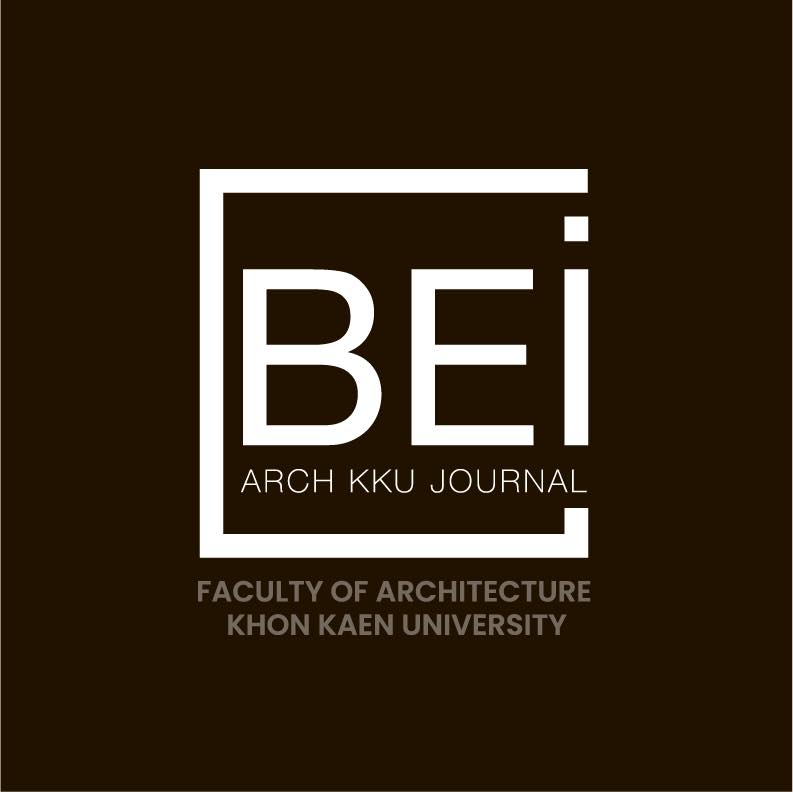หมู่บ้านไต บริบทของ “เฮือนไต” กับการท่องเที่ยวเชิงสถาปัตยกรรม
คำสำคัญ:
หมู่บ้านไต, บริบท, การท่องเที่ยวเชิงสถาปัตยกรรม, Tai village, Context, Architectural tourismบทคัดย่อ
บทความนี้ มีวัตถุประสงค์เพื่อศึกษาหมู่บ้านไตที่เป็นบริบทของบ้านพื้นถิ่นในลาว เมียนมาร์ ไทยเพื่อบูรณาการ องค์ความรู้ไปใช้ส่งเสริมการท่องเที่ยวเชิงสถาปัตยกรรมให้มีมิติที่หลากหลายและน่าสนใจมากขึ้น วิธีการศึกษา ได้ทำการศึกษาทบทวนวรรณกรรมหมู่บ้านไต ศึกษาหมู่บ้านจากภาพถ่ายทางอากาศ สำรวจและสัมภาษณ์เพื่อเข้าใจ ภูมิปัญญาในการตั้งถิ่นฐาน วิเคราะห์เลือกหมู่บ้านที่มีศักยภาพ สังเคราะห์องค์ความรู้หมู่บ้านไต ผลการศึกษา พบว่า 1) หมู่บ้านไต มีภูมิปัญญาการตั้งถิ่นฐานหมู่บ้านที่สัมพันธ์กับสภาพภูมิประเทศที่เป็นภูเขาสูง เป็นแหล่งต้นน้ำ และ มีที่ราบจำกัด สัมพันธ์กับวิถีชีวิตในสังคมเกษตรกรรม และคติความเชื่อในเรื่องผีและพุทธศาสนา จากกรณีศึกษา หมู่บ้าน 3 แห่งในลาว มีข้อจำกัดเรื่องเดินทางการเข้าถึงหมู่บ้านและสิ่งอำนวยความสะดวก แต่สิ่งที่งดงาม คือ ผู้คน วิถีชีวิต และสถาปัตยกรรมประเภทวัด ส่วนบ้านมีความเรียบง่าย หมู่บ้าน 5 แห่งในเมียนมาร์เป็นกลุ่มหมู่บ้านที่ มีความพร้อมมากที่สุดด้านการท่องเที่ยวเชิงสถาปัตยกรรม เพราะมีสภาพแวดล้อมทางธรรมชาติที่งดงาม สถาปัตยกรรม ทั้งวัดและบ้านมีความประณีต หมู่บ้าน 3 แห่งในไทย มีความพร้อมด้านการจัดการและสิ่งอำนวยความสะดวก เพื่อ รองรับการท่องเที่ยว ความเป็นคนไตยังมีอยู่ในวิถีและวัฒนธรรม แต่สถาปัตยกรรมทั้งวัด และบ้านเปลี่ยนแปลงไป จากเดิม 2) แนวความคิดในการบูรณาการองค์ความรู้เพื่อการท่องเที่ยวเชิงสถาปัตยกรรม คือ หมู่บ้านไตเป็นบริบท ของบ้านที่มีมิติอันหลากหลาย ซึ่งจะช่วยส่งเสริมให้การเที่ยวชมสถาปัตยกรรมบ้านพื้นถิ่นมีความน่าสนใจมากขึ้น
Tai Village: The Huean Tai Context and Architectural Tourism
Isara Guntang
The purposes of this study were study Tai villages in context of vernacular houses in Laos, Myanmar, Thailand and integrate knowledge to promote architectural tourism in variety of dimensions to be more interesting. Study method included a literary review on Tai villages. Study of aerial photography, survey and interview for understanding of local wisdom on settlements. Analysis to selection of villages. Data synthesis the knowledge of Tai villages. 2 major aspects: 1) Tai villages were based on village settlement wisdom in relation to topographical features comprising high mountains, water sources and limited amount of plains areas. Location had to go along with agrarian lifestyle and reflected their concern of animistic folk belief as well as Buddhist beliefs. 3 villages in Laos, problems due to lack of convenient travel routes and necessary facilities. However, beautiful impression could be derived from people, way of life and temple architecture.
In Myanmar 5 villages seemed to be the most ready for architectural tourism, having an attractive natural environment with elaborate architectural features of both temples and houses. In Thailand 3 villages appeared to be well equipped in terms of management and tourism facilities. Tai identity clearly remained in people’s lifestyle and culture even though architecture of temple and houses. 2) Context of integration of knowledge on architectural tourism could be developed in such a way that Tai village context involved multi-dimensional features to enhance vernacular architectural tourism.
ดาวน์โหลด
รูปแบบการอ้างอิง
ฉบับ
ประเภทบทความ
สัญญาอนุญาต
ทัศนะและข้อคิดเห็นของบทความที่ปรากฏในวารสารฉบับนี้เป็นของผู้เขียนแต่ละท่าน ไม่ถือว่าเป็นทัศนะและความรับผิดชอบของกองบรรณาธิการ




